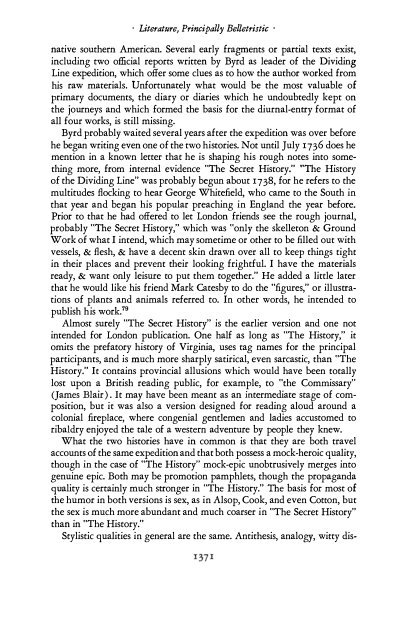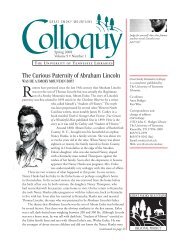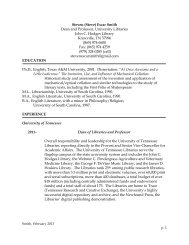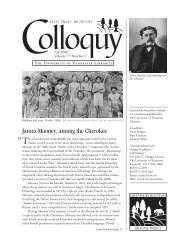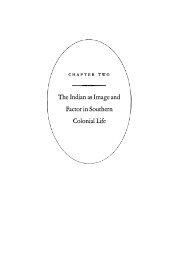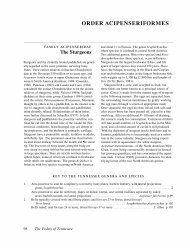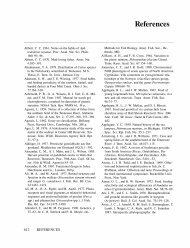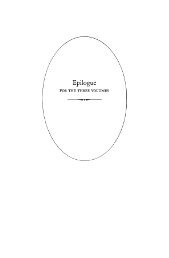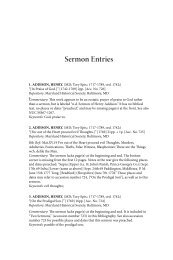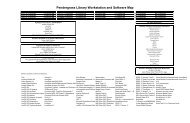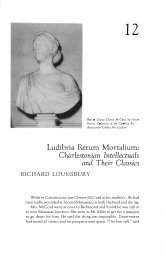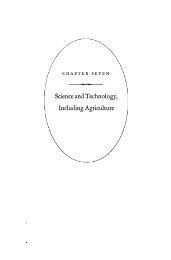Literature, Principally Belletristic - University of Tennessee, Knoxville
Literature, Principally Belletristic - University of Tennessee, Knoxville
Literature, Principally Belletristic - University of Tennessee, Knoxville
You also want an ePaper? Increase the reach of your titles
YUMPU automatically turns print PDFs into web optimized ePapers that Google loves.
· <strong>Literature</strong>, <strong>Principally</strong> <strong>Belletristic</strong> .<br />
native southern American. Several early fragments or partial texts exist,<br />
including two <strong>of</strong>ficial reports written by Byrd as leader <strong>of</strong> the Dividing<br />
Line expedition, which <strong>of</strong>fer some clues as to how the author worked from<br />
his raw materials. Unfortunately what would be the most valuable <strong>of</strong><br />
primary documents, the diary or diaries which he undoubtedly kept on<br />
the journeys and which formed the basis for the diurnal-entry format <strong>of</strong><br />
all four works, is still missing.<br />
Byrd probably waited several years after the expedition was over before<br />
he began writing even one <strong>of</strong> the two histories. Not until July 1736 does he<br />
mention in a known letter that he is shaping his rough notes into something<br />
more, from internal evidence "The Secret History." "The History<br />
<strong>of</strong> the Dividing Line" was probably begun about 1738, for he refers to the<br />
multitudes flocking to hear George Whitefield, who came to the South in<br />
that year and began his popular preaching in England the year before.<br />
Prior to that he had <strong>of</strong>fered to let London friends see the rough journal,<br />
probably "The Secret History," which was "only the skelleton & Ground<br />
Work <strong>of</strong> what I intend, which may sometime or other to be filled out with<br />
vessels, & flesh, & have a decent skin drawn over all to keep things tight<br />
in their places and prevent their looking frightful. I have the materials<br />
ready, & want only leisure to put them together." He added a little later<br />
that he would like his friend Mark Catesby to do the "figures," or illustrations<br />
<strong>of</strong> plants and animals referred to. In other words, he intended to<br />
publish his work. 79<br />
Almost surely "The Secret History" is the earlier version and one not<br />
intended for London publication. One half as long as "The History," it<br />
omits the prefatory history <strong>of</strong> Virginia, uses tag names for the principal<br />
participants, and is much more sharply satirical, even sarcastic, than "The<br />
History." It contains provincial allusions which would have been totally<br />
lost upon a British reading public, for example, to "the Commissary"<br />
(James Blair). It may have been meant as an intermediate stage <strong>of</strong> composition,<br />
but it was also a version designed for reading aloud around a<br />
colonial fireplace, where congenial gentlemen and ladies accustomed to<br />
ribaldry enjoyed the tale <strong>of</strong> a western adventure by people they knew.<br />
What the two histories have in common is that they are both travel<br />
accounts <strong>of</strong> the same expedition and that both possess a mock-heroic quality,<br />
though in the case <strong>of</strong> "The History" mock-epic unobtrusively merges into<br />
genuine epic. Both may be promotion pamphlets, though the propaganda<br />
quality is certainly much stronger in "The History." The basis for most <strong>of</strong><br />
the humor in both versions is sex, as in Alsop, Cook, and even Cotton, but<br />
the sex is much more abundant and much coarser in "The Secret History"<br />
than in "The History."<br />
Stylistic qualities in general are the same. Antithesis, analogy, witty dis-


